As a chef, your uniform or chef whites is a functional outfit symbolising your chef identity. To maintain a good professional image, you must wear a clean and well-maintained uniform showing that you take your work seriously, pay attention to detail and value personal and kitchen hygiene.
Given the nature of your work, this can be challenging.
To help you, this article details how you can keep your uniform clean and well-maintained. We first consider general tips for cleaning and caring for your uniform and, secondly, look at helpful hints for cleaning and maintaining each piece of your chef uniform: apron, coat, pants, hat and shoes.
18 Tips for cleaning and caring for the chef’s uniform.
1. Stick to the care label guide for each uniform part.
Before cleaning your chef’s uniform, check and adhere to the care label instructions for each uniform component. This is important as the best way to care for your chef pants may differ from that of your apron or chef coat.
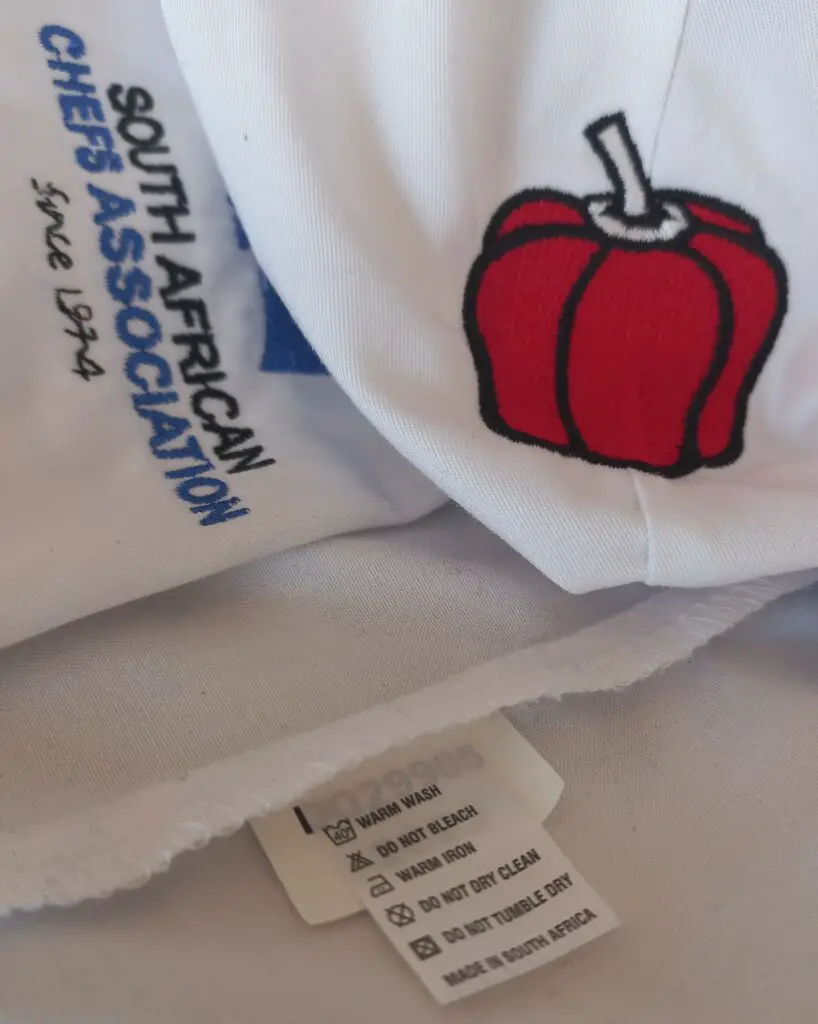
2. Do prompt and direct treatment of stains.
Pre-treat stains as soon as they occur at work. This prevents the stain from being absorbed into the fabric, making stain removal a lot harder later.
If you can’t attend to the stain immediately, do so as soon as possible. Keep on-the-go remedies like a stain stick that can be applied directly to the stained area on the fabric.
If you don’t have a stain stick, use household products like vinegar or baking soda. When using water to remove a stain, ensure that you use the proper water temperature, hot or cold, not to make the stain worse.
As stains also need to be treated according to the type of stain, check our article on keeping your chef coat white for tips on using household products and hot and cold water to remove stains.
Once you’ve treated the stained area, follow this up with a pre-soak once you get home and then launder.
3. Use a pre-treat, wash, dry, iron, and store well routine.
Regularly use this five-step routine to clean and care for your uniform:
1. pre-soak to remove stains and nasty smells and keep whites white;
2. wash in a mild detergent and at the proper temperature, usually warm water, according to the care label and wash whites with white;
3. hang out to line dry;
4. iron to get rid of creases;
5. store by hanging the uniform in a cool, dry place.
4. Pre-soak to remove stains and food smells.
Before washing your chef uniform, pre-treat by soaking it in a sink of warm water which is added and mixed one at a time: a ¼ cup of laundry detergent and ½ a cup of oxygen bleach. Submerge coat in solution and soak for 30 minutes. If heavily stained, soak for overnight. Launder as usual.
Pre-treating helps to:
- Remove stains.
- Remove food odours from working in the kitchen,
- Keep white uniform components, like the chef coat, white
Don’t skip pre-treating if your uniform has heavy or a build-up of stains from infrequent washing or is yellowing.
5. Wash your uniform after each or, at most, two wears.
The ideal is to wash your uniform after each wear or at least after two to three shifts. This is for two reasons:
1. Personal hygiene and mental well-being: A clean uniform daily helps you feel fresh and comfortable, considering the nature of a chef’s work, cooking in a hot kitchen and sweating.
2. Kitchen health and hygiene: working with food, your uniform will get food and food stains on it one way or another, accumulating germs and bacteria, making it unsafe and unhealthy to work to work in.
The best way to wear a clean uniform for each shift, is to have at least three uniforms, even if they are older, to rotate with daily and to wash your uniforms on your off days or, at worst in-between shifts.
Washing your uniform regularly means it will wear faster, so invest in durable, high-quality chef uniforms.
If changing your uniform daily is impossible or impractical as, given the nature of the work, many chefs are too exhausted after a long shift or don’t have a large enough chef wardrobe:
- Use a fabric protector to make it less likely for stains to absorb into the fabric of your uniform.
- Use a food-safe sanitiser to spray on your uniform to disinfect it.
- At the least, change your aprons more regularly.
6. Do a pre-wash scan of colours, pockets and turn-out items.
Do a routine pre-wash check to:
Separate different colours: Wash white uniform pieces like a white coat and apron separate from black chef pants, apron or coat.
Check your pockets: Check for objects in pockets like ink paper that can stain your uniform;

Remove pop-in buttons: If your coat has pop-in buttons, be sure to remove them from your jacket and do so before pre-soaking your coat. Place them in a container so they don’t go missing.
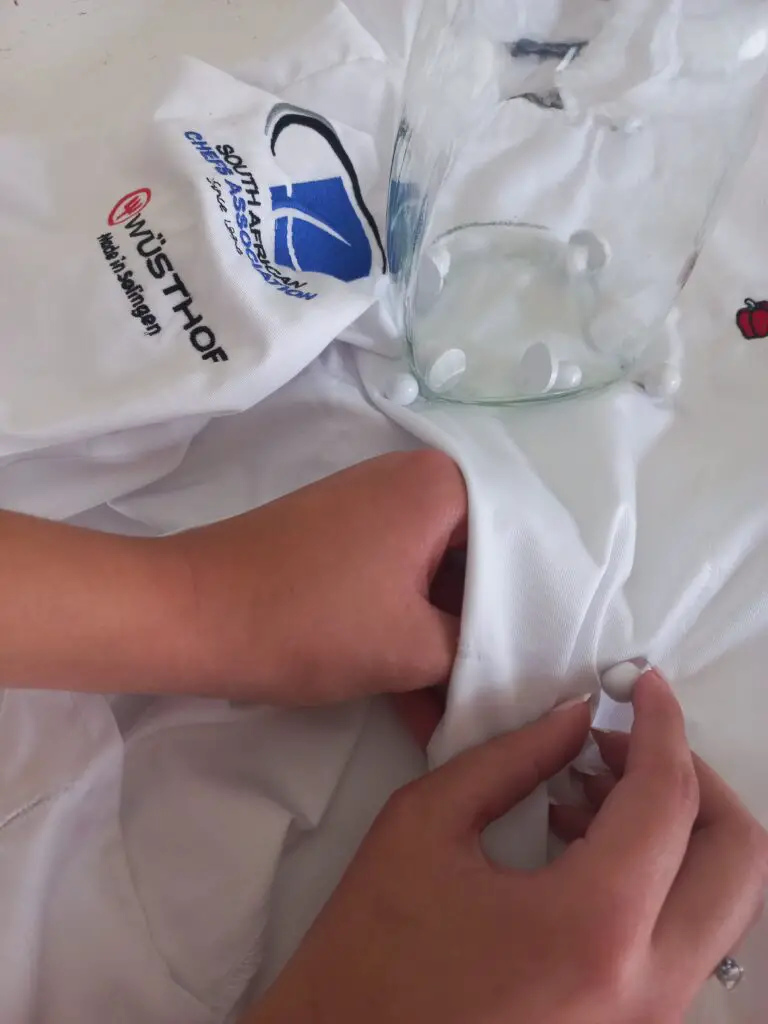
Turn out clothes: turn your chef pants and coat inside out before washing to prevent wear and protect embroidery on the uniform.
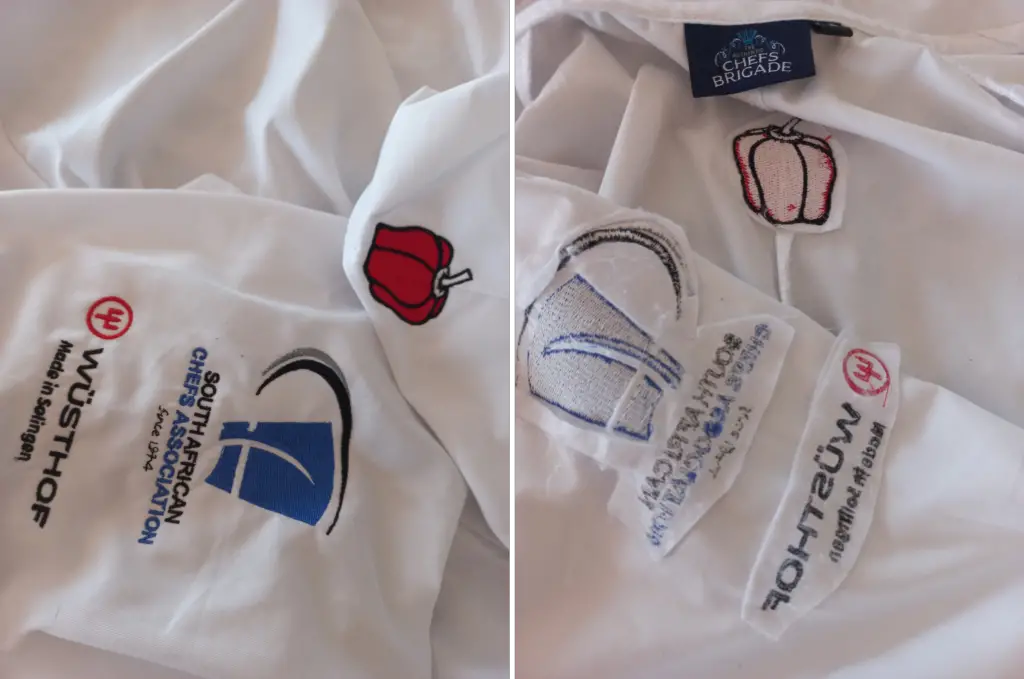
7. Wash at proper water temperature, usually a warm wash.
Most of your chef uniform components can be washed in warm water but check the care guide label for each uniform component first.
Keep a hot water wash for garments that have been stained, as this further helps the stain removal process, especially if you did not pre-treat stains and aids in getting rid of germs and bacteria on your uniform.
Use a good quality, mild detergent and follow the usage label.
8. Avoid the use of chlorine bleach and fabric softener.
Avoid the use of bleach and fabric softener when you wash your uniform. The residue left on the fabric from the softener can attract dirt and stains.
Fabric softeners use a conditioner to soften the fabric, and the residue left on the fabric from the softener can attract dirt and stains.
Vinegar can be used occasionally as a fabric softener as it has natural fabric softener properties.
However, do not use it as part of your regular laundry routine, as it could cause damage to some machines. There are alternative products, like Rinse and Refresh, that dissolve and don’t leave a residue.
Don’t use chlorine bleach to remove stains or keep your white chef clothes white. It will eventually cause a yellowing of the fabric and damage the protective properties of the material. Instead, use an oxygen-based bleach that is much milder than chlorine bleach.
9. Add vinegar to the rinse remove detergent residue.
If your coat is yellowing or your uniform is emerging from the washing, not smelling quite fresh but stale and mouldy, this could mean a product build-up from using the incorrect amount of laundry detergent and fabric softeners.
Adding ½ cup of vinegar to the rinse cycle, as a once-off or from time-to-time treatment, helps eliminate the excess residue and odour and helps whiten your coat.
Scientists and machine manufacturers warn that the ongoing use of vinegar in your machine can damage the seals and hoses and cause leaks. Of course, you may argue that so can the detergents and bleaches used in your machine, but it’s best to err on caution.
It’s also best to deal with the root and correctly use your laundry detergents or make informed product changes.
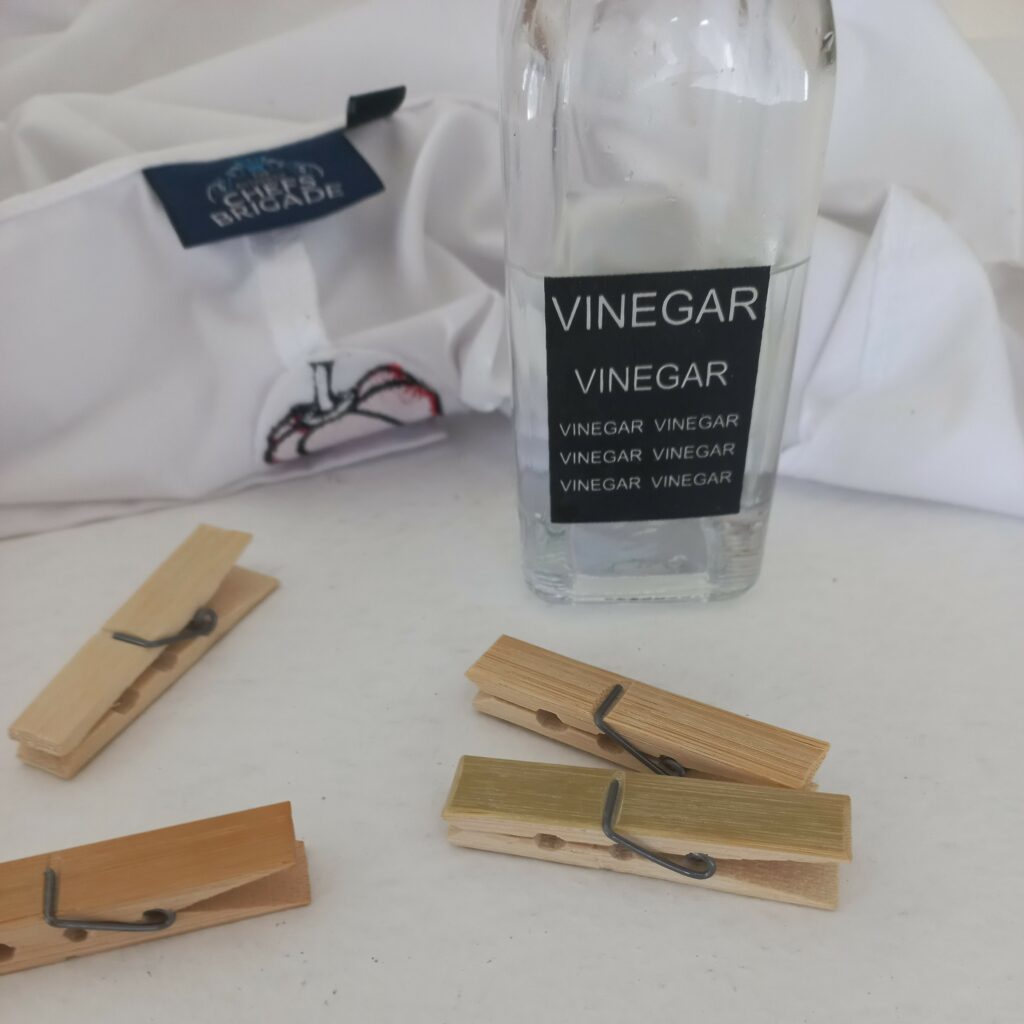
10. Don’t dry if uniform is not stain-free after washing.
If there are still stains on your uniform after laundering, don’t hang it out in the sun or place it in a dryer, as this can cause the stains to set into the fabric.
Instead, treat the stain again by applying a stain remedy directly to the stain or pre-soaking and washing again. The best is to remove a stain before washing your uniform.
11. Use durable, washable, breathable uniform fabric.
A good quality chef uniform must be comfortable and durable to withstand the kitchen’s heat and help keep a chef safe, but it must also be easy to clean and maintain. Investing in a high-quality chef uniform means your uniform will be more resilient to sustaining the many washes it must undergo.
12. Hang your uniform out to line dry but avoid direct sun.
This is a better alternative than using a tumble dryer. Avoid direct sunlight so harsh sunrays don’t damage the fabric of your chef uniform.
Still, by hanging your uniform outside, the sun’s light helps brighten your uniform and naturally kills any remaining germs. Hanging your uniform out to dry is also more environmentally friendly and saves power.
If you do use a tumble dryer, use low heat to prevent shrinkage and any remaining stains from setting in.
13. Iron damp, with a warm, clean iron to remove creases.
Chef uniforms are generally of cotton and a blend of cotton and polyester that needs ironing as it naturally creases when washed.
When ironing your chef uniform:
- Ensure the surface of the iron is clean to avoid stains,
- Iron your uniform on the wrong side, especially your black pants and apron, to avoid the seam impression shining through, making it look tatty.
- Iron the fabric when damp, using a steam iron or spraying water on the chef whites. The moisture makes it easier to iron out creases.
- Iron with a warm to hot iron, but first read the care label guide for the right temperature.
14. Correct use of products like detergent or whitener.
Follow the manufacturer guidelines for the cleaning products you use. An excess of a product can damage the fabric of your chef uniform, and an insufficient amount may not properly clean your garments.
15. Build a supply of uniforms and keep a backup at work.
Build a supply of chef uniforms so that you can work to the ideal and wear a clean uniform for each shift.
Having a supply of uniforms means you can also keep a backup uniform at work to change when you need to treat a stain on your uniform. This way, you don’t have to work in the discomfort of a wet uniform.
Lastly, a backup uniform is handy when you need a clean uniform because you need to engage with guests and appear clean and professional, and your uniform, even the double-sided flap, is soiled.
16. To store, hang a not-in-use uniform in a cool, dry place.
Correctly storing your chef uniform will make it last longer.
Your washed and ironed chef uniform is best placed in a hanger and hung in a cool, dry cupboard rather than in a hot, humid space where mildew can form.
If you can, hang it in a garment bag to prevent dust from falling on it.
For many chefs, it’s not realistic to wash their uniform after each use, and hence it is vital to take proper care of it after your shift.
Tired as you are, hang up your chef uniform as soon as you change out of it so that it maintains its shape and can be used again. Leaving it in a pile on the floor will cause wrinkles and creases, and your uniform will likely pick up dirt or hair, making it unhygienic for use in the kitchen.
17. Wear your uniform in the kitchen only.
Try to wear your uniform in the kitchen only. By doing this, you will extend the life span of your uniform, and it will need replacing less sooner.
If you can change out of it before you leave work and if you have to re-use it, hang it at work if there are lockers or a suitable storage place.
Alternatively, change out of your uniform as soon as you get home. Avoid running errands or relaxing at home in your uniform, running the risk of damage like tearing or staining it.
18. Use old chef coats and aprons for dirty kitchen work.
Keep and don’t discard your old chef coats, aprons and pants. Change into it when you know you will be working with food that causes heavy staining or dirty, grimy kitchen work like cleaning grease traps. It is also backup to wear when a stained uniform needs removal to de-stain or is too wet to wear.
Tips for cleaning and caring for each uniform piece.
Below are best practices for cleaning and maintaining the various components of the complete chef uniform: apron, coat, pants, hat and shoes. Please read our two articles for a complete description of the chef uniform and its value.
The Apron: How to clean and maintain
The apron protects your chef coat and is the first line of defence from spills and splashes. It must be regularly washed, preferably after each, to keep it clean and hygienic and prevent a build of food particles, grease and bacteria. If this is impossible, build up a supply of aprons to change it after each shift.
If you have a white apron, avoid using chlorine bleach or fabric softener, as it can damage the fabric, rendering it less protective.
When line hanging your apron to dry, hang it at the bottom.
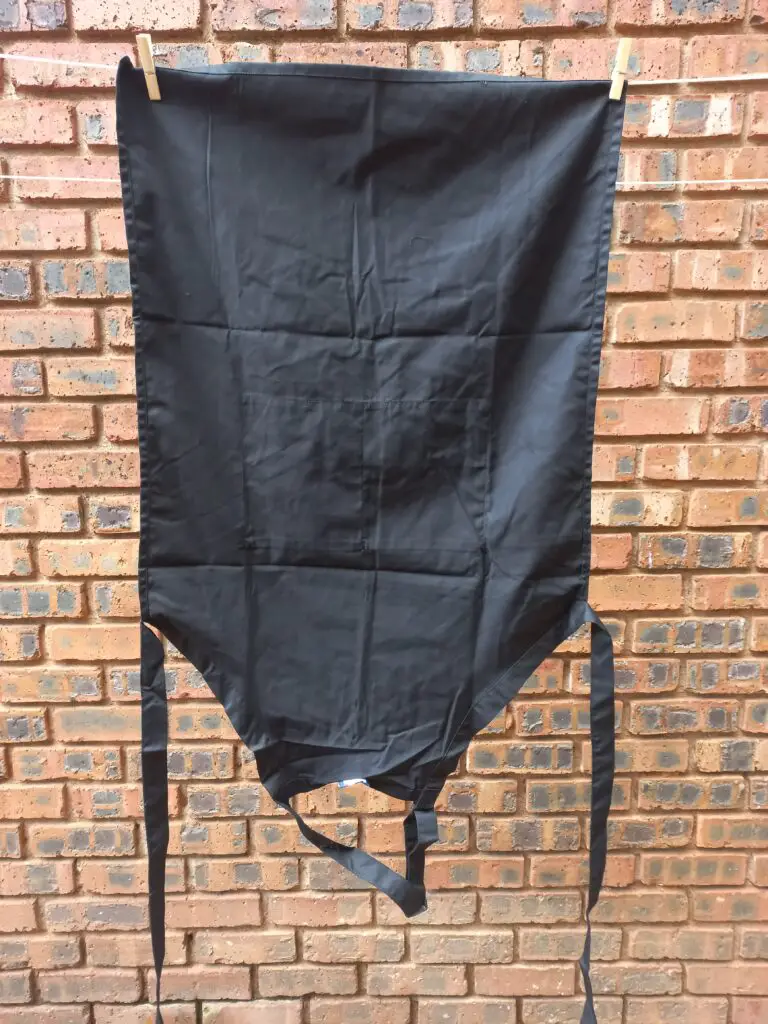
The Chef coat: How to clean and maintain.
The chef’s coat, while giving a professional appearance, is also functional and meant to protect you from injury from hot food splashes and spills.
A white chef’s coat must be kept clean as it is the most visible part of the uniform and what people first notice. If not properly cleaned and maintained, it can detract from the professional look.
As the chef coat is such an essential part of the uniform, we’ve written an in-depth article for you to read on keeping your chef coat white, whitening your yellowing jacket, and removing stains from your white jacket.
The Chef pants: How to clean and maintain.
The chef’s pants protect the chef’s legs from injury while working in a hot kitchen. It is also designed for comfort and made of durable and breathable fabric.
To clean and care for your chef pants:
- Check the pockets for any objects like pens or tissues.
- When washing the chef’s pants, turn them inside out and wash them in warm water using a mild detergent.
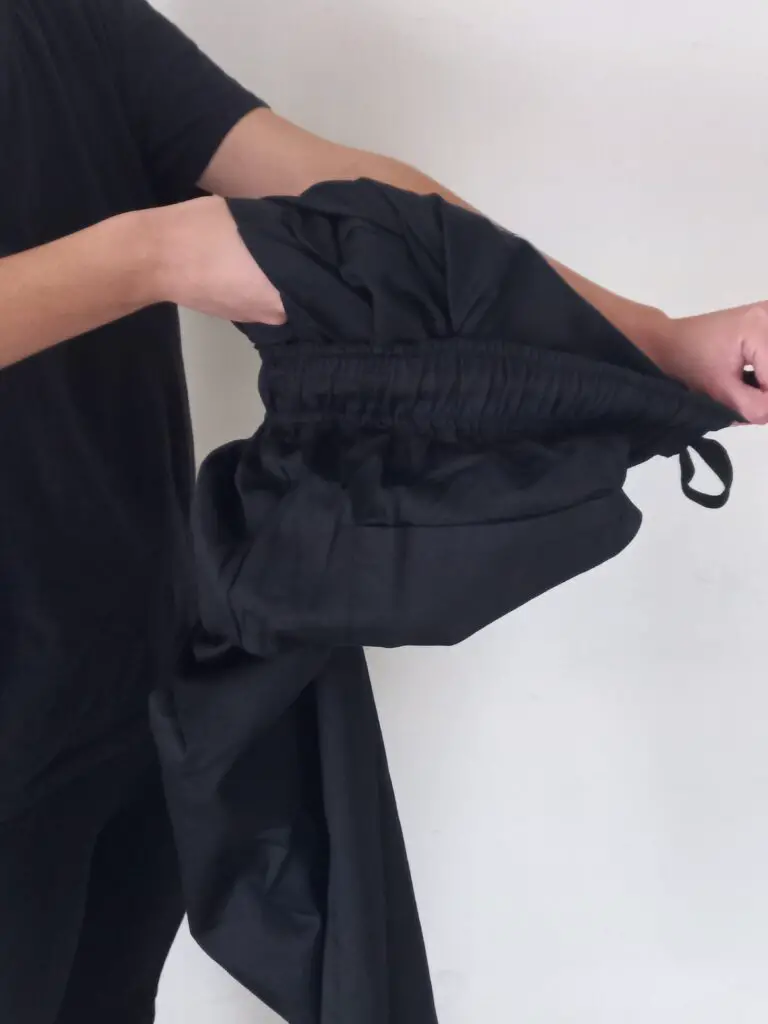
- Wash separately from the white uniform components like your coat or white apron.
- Hang out to line dry but ensure that:
- The pants are inside out to avoid fading of the colour.
- Hang at the waist for faster drying so that the peg marks are inconspicuous.
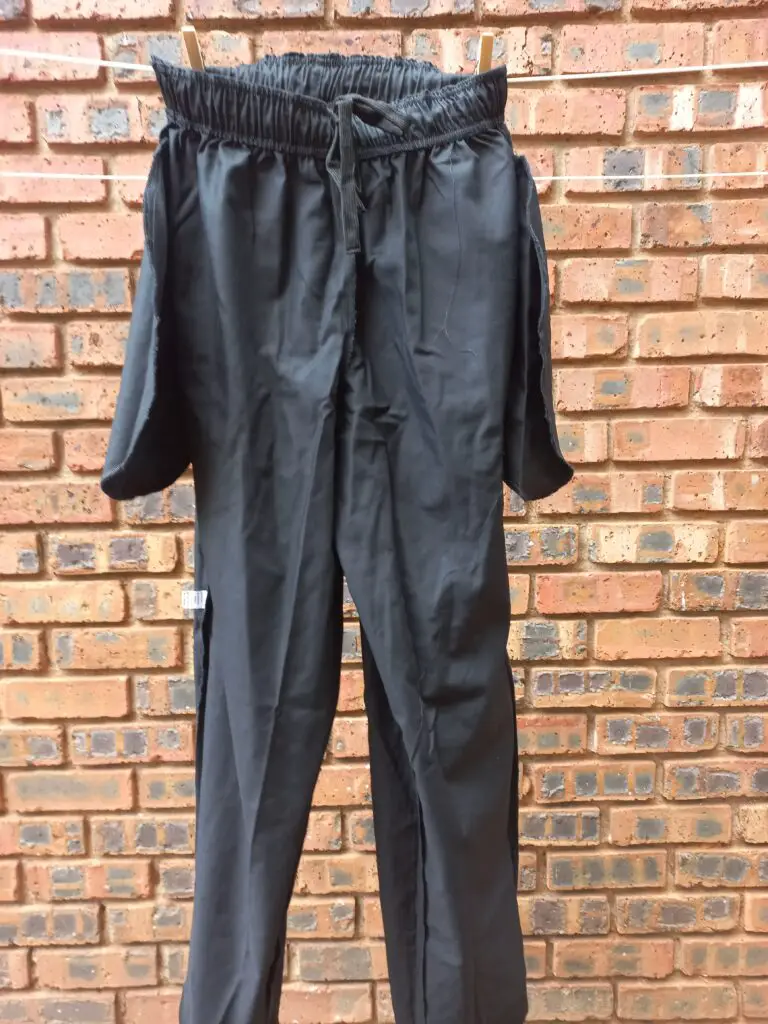
- Iron them when slightly damp to prevent wrinkles.
Chef hat: How to clean and maintain
While the chef’s hat is the classical symbol of the profession, it serves the practical purpose of keeping the chef’s hair out of their face and the food while cooking. Chef hats are typically made of cotton or a cotton-polyester blend, making cleaning easier.
To clean and care for your chef hat:
- Hand wash your chef hat in warm water with mild detergent.
- Rinse the cap thoroughly and gently sponge excess water with a dry towel. Do not wring it out.
- Re-shape your hat while it is still wet.
- Hang it out to air dry or place it on a flat surface.
Chef shoes: How to clean and maintain
As chefs stand for many hours, chef shoes are a critical part of the uniform, providing the necessary support and protection for your feet.
To clean and care for your chef shoes:
- Use a wet cloth to remove dirt or debris and to wipe the shoes down.
- Gently scrub off any stubborn stains using a soft-bristled brush.
- Hand wash them in warm water and a mild detergent.
- Stuff with newspaper to maintain shape and place it on a clean surface to air dry.
- If the shoes are machine washable, follow the care label.
To conclude, while maintaining your uniform takes time and effort, a clean and well-cared-for chef uniform makes you look and feel like you’re professional. It shows commitment to your career and the profession and that you are serious about the image you portray doing it.


